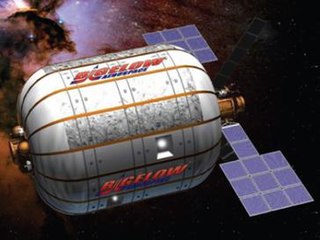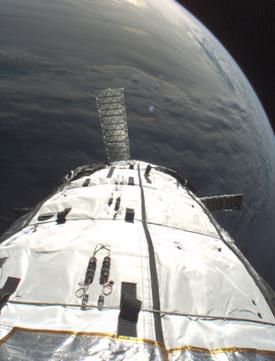
Atmospheric entry is the movement of an object from outer space into and through the gases of an atmosphere of a planet, dwarf planet, or natural satellite. There are two main types of atmospheric entry: uncontrolled entry, such as the entry of astronomical objects, space debris, or bolides; and controlled entry of a spacecraft capable of being navigated or following a predetermined course. Technologies and procedures allowing the controlled atmospheric entry, descent, and landing of spacecraft are collectively termed as EDL.

A reusable launch vehicle have parts that can be recovered and reflown, while carrying payloads from the surface to outer space. Rocket stages are the most common launch vehicle parts aimed for reuse. Smaller parts such as rocket engines and boosters can also be reused, though reusable spacecraft may be launched on top of an expendable launch vehicle. Reusable launch vehicles do not need to make these parts for each launch, therefore reducing its launch cost significantly. However, these benefits are diminished by the cost of recovery and refurbishment.

Vectran is a manufactured fiber, spun from a liquid-crystal polymer (LCP) created by Celanese Corporation and now manufactured by Kuraray. Chemically it is an aromatic polyester produced by the polycondensation of 4-hydroxybenzoic acid and 6-hydroxynaphthalene-2-carboxylic acid.

TransHab was a concept pursued by NASA in the 1990s to develop the technology for expandable habitats inflated by air in space. Specifically, TransHab was intended as a replacement for the already existing rigid International Space Station crew Habitation Module. When deflated, inflatable modules provide an 'easier to launch' compact form. When fully inflated, TransHab would expand to 8.2 metres (27 ft) in diameter.
Bigelow Aerospace is an American aeronautics and outer space technology company which manufactures and develops expandable space station modules. Bigelow Aerospace was founded by Robert Bigelow in 1998, and is based in North Las Vegas, Nevada. It is funded in large part by the profit Bigelow gained through his ownership of the hotel chain, Budget Suites of America.

The ballute is a parachute-like braking device optimized for use at high altitudes and supersonic velocities.

Aerocapture is an orbital transfer maneuver in which a spacecraft uses aerodynamic drag force from a single pass through a planetary atmosphere to decelerate and achieve orbit insertion.

ILC Dover, LP is a special engineering development and manufacturing company, globally headquartered in Newark, Delaware. ILC Dover specializes in the use of high-performance flexible materials, serving the aerospace, personal protection, and pharmaceutical industries.

The B330 was an inflatable space habitat being privately developed by Bigelow Aerospace from 2010 until 2020. The design was evolved from NASA's TransHab habitat concept. B330 will have 330 cubic meters (12,000 cu ft) of internal volume, hence its numeric designation.

Genesis I is an experimental space habitat designed and built by the private American firm Bigelow Aerospace and launched in 2006. It was the first module to be sent into orbit by the company, and tested various systems, materials and techniques related to determining the viability of long-term inflatable space structures through 2008. Such structures, including this module and others built by Bigelow Aerospace, were similar to the 1990s NASA expandable TransHab design, which aimed to provide increased interior volume at a reduced launch diameter and potentially reduced mass compared to traditional rigid structures.

Genesis II is the second experimental space habitat designed and built by the private American firm Bigelow Aerospace, launched in 2007. As the second module sent into orbit by the company, this spacecraft builds on the data and experience gleaned from its previously orbited sister-ship Genesis I. Like its sister-ship and other modules being designed by Bigelow Aerospace, this spacecraft is based on the NASA TransHab design, which provides increased interior volume and reduced launch diameter along with potentially reduced mass compared to traditional rigid structures.

Inflatable habitats or expandable habitats are pressurized tent-like structures capable of supporting life in outer space whose internal volume increases after launch. They have frequently been proposed for use in space applications to provide a greater volume of living space for a given mass.

Space architecture is the theory and practice of designing and building inhabited environments in outer space. This mission statement for space architecture was developed at the World Space Congress in Houston in 2002 by members of the Technical Aerospace Architecture Subcommittee of the American Institute of Aeronautics and Astronautics (AIAA). The architectural approach to spacecraft design addresses the total built environment. It is mainly based on the field of engineering, but also involves diverse disciplines such as physiology, psychology, and sociology.
The Bigelow Next-Generation Commercial Space Station was a private orbital space station under conceptual development by Bigelow Aerospace in the 2000s and 2010s. Previous concepts of the space station had included multiple modules such as two B330 expandable spacecraft modules as well as a central docking node, propulsion, solar arrays, and attached crew capsules. However it was also suggested that each B330 can operate as an independent space station. Attaching a B330 to the International Space Station or flying a B330 alone have been suggested by Robert Bigelow.

Mars atmospheric entry is the entry into the atmosphere of Mars. High velocity entry into Martian air creates a CO2-N2 plasma, as opposed to O2-N2 for Earth air. Mars entry is affected by the radiative effects of hot CO2 gas and Martian dust suspended in the air. Flight regimes for entry, descent, and landing systems include aerocapture, hypersonic, supersonic, and subsonic.

The Bigelow Expandable Activity Module (BEAM) is an experimental expandable space station module developed by Bigelow Aerospace, under contract to NASA, for testing as a temporary module on the International Space Station (ISS) from 2016 to at most 2028, when the contract can not be extended any further. It arrived at the ISS on 10 April 2016, was berthed to the station on 16 April 2016, and was expanded and pressurized on 28 May 2016. Although originally planned to be a two year test, it has exceeded expectations and is used as additional cargo storage. The module is under ownership of NASA after Bigelow Aerospace suspended operations in 2021.

Austere Human Missions to Mars is a concept for a human mission to Mars by the United States space agency, NASA. Released in 2009, it proposed a modified and even less costly version of Design Reference Architecture (DRA) 5.0, itself a combination of nearly 20 years of Mars planning design work. The mission profile was for a conjunction class with a long surface stay, pre-deployed cargo, aerocapture and propulsive capture, and some in-situ resource production. As of 2015, the concept had not yet been adapted to the Space Launch System that replaced NASA's Constellation program in 2011.

Axiom Orbital Segment or Axiom Segment are the planned modular components of the International Space Station (ISS) designed by Axiom Space for commercial space activities. Axiom Space gained initial NASA approval for the venture in January 2020. Axiom Space was later awarded the contract by NASA on February 28, 2020. This orbital station will be separated from the ISS to become its own modular space station, Axiom Station, after the ISS is decommissioned.
Orbital Reef is a planned low Earth orbit (LEO) space station designed by Blue Origin and Sierra Nevada Corporation's Sierra Space for commercial space activities and space tourism uses. Blue Origin has referred to it as a "mixed-use business park". The companies released preliminary plans on 25 October 2021. The station is being designed to support 10 persons in 830 m3 of volume. The station is expected to be operational by 2027.

Low-Earth Orbit Flight Test of an Inflatable Decelerator (LOFTID) was a NASA mission to test inflatable reentry systems. It was the first such test of an inflatable decelerator from Earth-orbital speed.

















